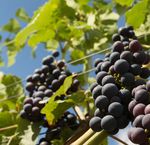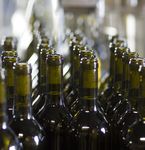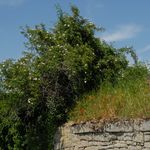BIODIVERSITY PROTECTION IN VITICULTURE IN EUROPE - Bodensee ...
←
→
Page content transcription
If your browser does not render page correctly, please read the page content below
Fact Sheet
BIODIVERSITY
PROTECTION
IN VITICULTURE
IN EUROPE
WHAT IS BIODIVERSITY?
Biodiversity - or biological diversity - is the term given to the variety of life on Earth. In a
vineyard, the biodiversity is the diversity of animals, plants and micro-organisms, at the
genetic, species and ecosystem level. This diversity is necessary to sustain key functions,
structures and processes in this agro-ecosystem. Biodiversity is therefore a broad term that
encompasses the diversity of agricultural and natural ecosystems.
WHY IS IT IMPORTANT?
Biodiversity and agriculture are strongly interrelated. In the past, agriculture significantly
contributed to the increase of cultural landscape and species diversity in Europe, but no-
wadays agriculture intensification is one of the main drivers of biodiversity loss. Sometimes
some species can be critical for agricultural production, but agriculture also depends stron-
gly on what nature is giving – and biodiversity plays a major role in providing those natural
gifts, such as:
Soil formation Maintenance of the hydrological cycle Nutrient cycling
Erosion control Pest and disease regulation Climate regulation Pollination
Carbon sequestration
The term “agricultural biodiversity” encompasses socio-cultural, economic and environ-
mental elements.POSITIVE IMPACTS OF BIODIVERSITY MANAGEMENT IN THE VINEYARD
The more diverse a system is, the more resilient or self-regulating it will be. Biodiversity
management in vineyards has a positive impact on the crop.
To ensure a biodiverse vineyard environment, it is key to conserve the habitat and species within. A
balanced and natural vineyard environment, with a diverse agro-ecosystem of plants and animals,
enhances the grape and wine production in the long term. Almost all evolved animal and plant
species related to the natural viticultural landscape benefit the farmers, for example, by combating
pests and providing a rich soil and humus to the vine plant. To provide these benefits, the farm area
has to be managed in a way that enhances the botanical and faunistic components. In the following
we highlight some key management elements for enhancing biodiversity:
GRAPE VARIETIES flowers etc. contribute to the sustainable
management of the crop as it attracts
Genetic diversity is beneficial organisms, which prey
always very valuable. on pest species and therefore
In some countries, reduce the need for spraying
genetic diversity has pesticides. Cover crops
been the basis for also improve the soil by
the development of fertilizing it, reducing soil
blended wines. These wines erosion, and can be reused
have balanced profiles, gathering the best as mulch, which has similar
characteristics of each variety. Preserving beneficial properties.
a high number of varieties – some very old
and resilient – also has a high environmental HEDGEROWS
benefit, as a genetic variety is ensured. In
a changing climate this will provide a good Lines of shrubs and trees are important
source for adaptation measures. elements of agricultural biodiversity. They
diversify the landscape and provide habitats
DRY STONE WALLS for plants and animals e.g. by producing
shadow and providing nesting places for
It is important to build or restore this kind several bird species. Hedgerows also function
of infrastructure, as it protects and provides as windbreaks, helping to reduce soil erosion
shelter for several species of birds, from wind and rain and helping to
reptiles, insects and spiders. protect young seedlings and crops.
They reduce the drying effects of
COVER CROPS wind on soil and plants, and act
as barriers to avoid pesticide drift.
Natural or seeded vegetation An additional effect is that they
between vine rows, especially can prevent the spread of invasive
when they contain herbs, alien plants.
ONTROL
BIOLOGICAL PEST C
Cover crops and other ecological infrastructures provide habitat, shelter and food for several
beneficial organisms (e.g. ladybirds and wasps). These beneficials in turn reduce the presence of
grapevine pests, through parasitism or predation. In the same way, the implementation of nest
boxes allows some insectivorous birds to remain in vineyards, contributing to the reduction of
grapevine pests as well.BIODIVERSITY BEYOND THE FARM LEVEL
Each winery can contribute to the enhancement of biodiversity even beyond the
farm level, through decisions about what products, commodities and materials
are purchased. Important questions farmers can ask themselves are: How
can I optimize the transport? Do the bottles I use have the highest recycling
content? Am I using lighter glass? Or will I continue to use cork as a bottle
closure?
The preference for cork closures is an example of this, as it
conserves Mediterranean cork oak forests. Cork is a 100% sus-
tainable and renewable natural resource that can be recycled
into dozens of new products. The cork oak’s fire-resistant bark protects it from
wildfires that frequently devastate the region, leaving only the cork oak groves
to prevent soil erosion, desertification and preserve wildlife habitats. The cork
oak also plays a crucial role in CO2 retention.
LEGISLATION ON BIODIVERSITY
The European Union Biodiversity Strategy aims to halt the loss of biodiversity and
ecosystem services in the EU and help stop global biodiversity loss by 2020.
» http://bit.ly/29SGDmp
Birds Directive: The Birds Directive aims to protect all of the 500 wild bird species naturally
occurring in the European Union. » http://bit.ly/1nahKR3
Habitats Directive: The Habitats Directive ensures the conservation of a wide range of rare,
threatened or endemic animal and plant species. » http://bit.ly/1Ee1v4R
EU Regulation 1143/2014 on Invasive Alien Species: This Regulation seeks to address the
problem of invasive alien species in a comprehensive manner to protect native biodiversity
and ecosystem services. » http://bit.ly/151Jrdc
BIODIVERSITY MANAGEMENT: EXPERIENCE FROM OTHERS
TURKEY
Topic ˡˡ Green Manuring and cover
Company ˡˡ Rapunzel Organic Agriculture contracted farmers
What was the problem? ˡˡ Lack of green manuring, lack of host plants for beneficials
How was it solved? ˡˡ The Company distributed vetch seeds to the farmers. Now farmers are able
to enhance soil aeration and quality. Vetch seeds also increase the available nitrogen in the soil and
increase the availability of nitrogen for the vine plants through symbiosis with rhizobium.
Results ˡˡ Farmers do not need to buy fertilizers as the vetch plants provide enough nitrogen. Be-
neficial insects are more present than before as well.I
Investment and benefit obtained ˡˡ The investments were the costs for the vetch seeds. The be-
nefits were nitrogen fertilization and increasing the population of beneficial organisms.
References ˡˡ http://www.rapunzel.com.tr/index.php?plink=rapunzel-organic-farming-projectsPORTUGAL Topic ˡˡ Business and Biodiversity Company ˡˡ Duorum Vinhos What was the problem? ˡˡ The company wanted to develop a new vineyard, in a field located inside a classified Natura 2000 area. The presence of several endangered species of “birds of prey”, required a detailed incidence assessments of the site regarding birdlife. The conservation of these birds was made a priority and there therefore was a big challenge on how to cultivate the vines while ensuring an effective protection of the habitat and species. How was it solved? ˡˡ The company implemented an extensive set of impact mitigation and biodi- versity promotion actions which were detailed in a Biodiversity Conservation Plan and were monito- red. The monitoring results were reported annually as a voluntary commitment under the Portugue- se state program “Business and Biodiversity”. During the process, the presence of Oenanthe leucura (common name ”chasco preto” or “Port wine little bird”) was discovered and a further management process to protect this specie, as well, was developed. This specie is now the „face“ of one of Duo- rum Vinhos top wines, depicting the bird on its bottle´s labeling. Results ˡˡ The Company is successfully producing top quality wines with an exporting profile, while preserving priority species and sensitive characteristics of the countryside.I Investment and benefit obtained ˡˡ A big investment was made in the conservation actions and evaluation of its impacts. The benefits were primarily for nature, but there was also a benefit for the company, who developed stronger sale arguments and new market opportunities. References ˡˡ http://www.duorum.pt/sustentabilidade/default.aspx?title=sustentabilidade&idioma=en# SPAIN Topic ˡˡ Biological control with bats Company ˡˡ Bodegas Enguera / Valencia What was the problem? ˡˡ Grape moth (Lobesia botrana) is a common pest in vineyards. It is a micro moth (Lepidoptera) that harms the grapes. It has been traditionally controlled by spraying chemicals, and lately using pheromones confusion, the latter being a much more environmentally- friendly approach but still needing an annual investment. How was it solved? ˡˡ Bodegas Enguera decided to install bat refuges around their vineyards in order to control grape moth populations in a more environmentally-friendly way but also with a lo- wer cost. Pheromone traps were kept as a control, and once the bat refuges were installed, no more Lobesia specimens were captured on the traps. This pest was therefore entirely controlled thanks to the bat populations established in the vineyard. Results ˡˡ The installation of more than 200 bat refuges has been successful in the control of a common pest in vineyards, with a low investment and very low maintenance cost in the long-term.I Investment and benefit obtained ˡˡ This case study highlights how working with biodiversity can entail management and economic benefits. References ˡˡ http://www.bodegasenguera.com/#
GERMANY
Topic ˡˡ Use of cork
Company ˡˡ Winery Brühler Hof (Müller Family) / Rheinhessen
What was the problem? ˡˡ In the last years, many winemakers have reduced or even stopped the
use of natural cork in favor of aluminum closures due to different reasons (leakages, cork taste, cost,
practicality and marketing). The process of aluminum production has very high negative environ-
mental impacts (energy intensive and large landscape use for mining bauxite) and a reduced use of
cork has serious impacts for the cork oak forests in Spain and Portugal.
How was it solved? ˡˡ Despite the problems detected in the past with cork, winery Brühler Hof
keeps using this material. Firstly, because the quality of cork has improved in the last years, and se-
condly because the family is very dedicated to the preservation of cork oak forests.
Results ˡˡ The commitment to the cork forests is so strong that the winery will collect the corks
that the customers bring back and send them to recycling centers, or give them to an artist for the
production of furniture.I
Investment and benefit obtained ˡˡ Cork closures are more expensive than aluminum closures;
instead of 8 Cents for an aluminum LongCap, the cork closure might cost 35 Cents or more. But, cork
conveys a lot of what is important to the Müllers in respect to culture, wine and ecology. It brings
them one step closer to their goal of a sustainable, CO2-neutral wine production.
References ˡˡ http://www.bruehler-hof.de/
THE PARTNERSHIP FOR BIODIVERSITY PROTECTION IN VITICULTURE IN EUROPE ...
aims at adapting vine-growing practices to protect, enhance and promote the biodiversity
in vineyards, through the development of analysis modules and trainings around Germany,
Turkey, Portugal and Spain.
Germany La Unió Co-funded by the
José Castro León Erasmus+ Programme
Bodensee-Sti�ung jcastro@launio.org of the European Union
Dr. Kerstin Fröhle
Kerstin.froehle@bodensee-stiftung.org Portugal „The European Commission
support for the production of this
publication does not constitute
Quercus an endorsement of the contents
Global Nature Fund Paula Lopes da Silva which reflects the views only of
Dr. Thomas Schaefer paulasilva@quercus.pt the authors, and the Commission
schaefer@globalnature.org cannot be held responsible for any
use which may be made of the
information contained therein.“
ADVID Project-Nr.: 2015-1-DE02-
ECOVIN - Bundesverband Associação para o KA202-002387
Okologischer Weinbau e. V. Desenvolvimento
Ralph Dejas da Viticultura Duriense
r.dejas@ecovin.de Cristina Carlos Picture credits:
cristina.carlos@advid.pt Thomas Schaefer|GNF
(front page, page 2, *hedges*)
Spain
deiniberischerschinken.com
Fundación Global Nature
Turkey (page 3 *cork oak forest*)
Cristina Carlos|ADVID
Ernesto Aguirre y Jordi Domingo Rapunzel Organik Tarım Ürünleri (page 4)
eaguirre@fundacionglobalnature.org ve Gıda Tic. Ltd. Şti. FGN
jdomingo@fundacionglobalnature.org (page 5)
Sahin Ince & Emrah Dağdeviren
sahin.ince@rapunzel.com.tr Bertram|ECOVIN
emrah.dagdeviren@rapunzel.com.tr (page 2,3)
Copyright
This document was elaborated by the partners of the project „Partnership for Biodiversity Protection in Viticulture in Europe” and can be downloaded and used free of
charge by any person, provided it does not undermine its importance and commitment to quote the authors.
Members of the partnership: Bodensee-Stiftung | Global Nature Fund | ECOVIN | Fundación Global Nature | La Unió de Llauradors | Quercus Associação Nacional de
Conservação da Natureza | ADVID - Associacao para o Desenvolvimento da Viticultura Duriense | Rapunzel Organik tarmi Ürünleri ve Gida Tic. Ltd. Sti.
However, this document is subject to the following licence:
Creative Commons Attribution-NonCommercial-ShareAlike 4.0 International (CC BY-NC-SA, https://creativecommons.org/licenses/by-nc-sa/4.0/legalcode):
When sharing or adapting you have to refer to either to the project or name all members of the partnership.
The images and logos in this document are not subject to the licence CC-BY-NC-SA. The logos are the property of the respective organisation, the pictures are the
property of the persons/institutes named in the picture credits.You can also read

























































